Original Author: Rui
Original Compilation: Saoirse, Foresight News
Hyperliquid has ignited a fervent phase for decentralized perpetual contract exchanges (Perp DEX), capturing 8.62% of the traffic from centralized exchanges (CEX). However, we must confront some latent issues in this field and build a framework to ensure that the transition towards decentralization is truly irreversible.
TL;DR
- Illusion of Liquidity: High trading volume ≠ good liquidity. Bid-ask spreads, slippage, and taker fees can lead to price impact and execution loss, but related metrics may be artificially inflated due to incentive mechanisms.
- Hidden Costs: The order book model requires substantial subsidies from market makers, while liquidity providers (LP) in automated market makers (AMM) struggle to scale, both facing economic challenges.
- Black Box Liquidation: System security must be prioritized over user convenience, necessitating risk control for open interest (OI), multi-source liquidation mechanisms, and verifiable proofs, especially in pre-market trading scenarios where risks are particularly pronounced.
- Trade Order Sacrifice: There is a trade-off between prioritizing retail traders or high-frequency trading (HFT), which fundamentally is a choice between fairness and efficiency.
- Inefficient Margin: A dynamic and efficient margin system needs to be established, incorporating interest-bearing collateral, lending integration, and hedge identification functions to match the efficiency of centralized exchanges.
Illusion of Liquidity
Although trading volume is a conventional metric, it can be misleading when token incentives artificially generate false trading. Even with the same trading volume data, retail trading is more valuable than "speculative trading" because it is more stable and sustainable.
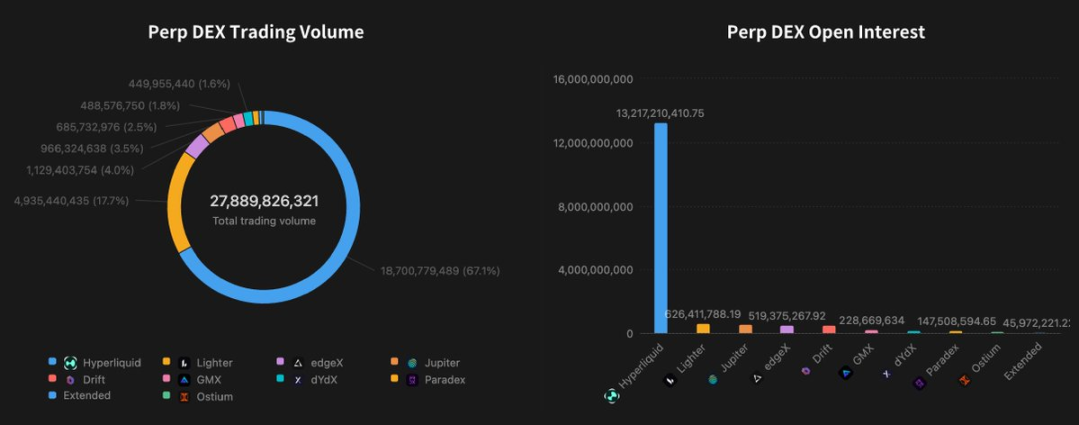
Perp DEX Trading Volume and Open Interest
The ratio of open interest to trading volume (OI-to-Volume) can reflect true trading activity. Centralized exchanges without APIs typically show a ratio of 1:2 or 1:3. Hyperliquid's hourly fee rate and order cancellation priority mechanism achieve a higher ratio of 1:1, while other decentralized exchanges that have not issued tokens often have lower ratios due to token incentives driving false trading to inflate trading volume. Additionally, fee income is crucial for platform sustainability, providing incentives and directly constituting a safety buffer.
Liquidity is the ultimate standard for measuring platform usability. Narrow bid-ask spreads can reduce the cost of entering and exiting the market, low slippage ensures stable pricing for large orders, and sufficient market depth can prevent price fluctuations during trading. From comparative data, Hyperliquid excels in handling large positions over $20 million; while edgeX is more friendly to retail traders, offering the deepest liquidity within 1 basis point (bps), the lowest slippage for most trade sizes, and the narrowest spreads.
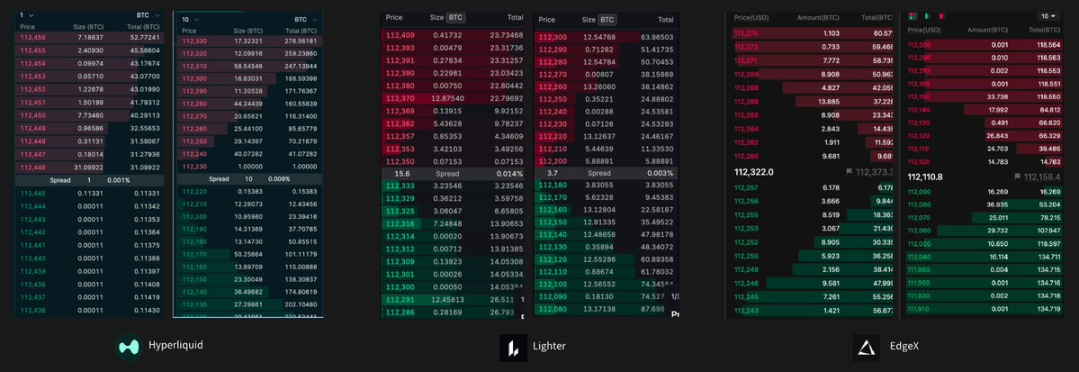
Order Book Comparison
Hidden Costs
Liquidity is a typical "cold start problem": traders are unwilling to enter platforms with sparse orders, and market makers will also avoid platforms with insufficient liquidity.
The order book model is more capital efficient but requires substantial upfront capital for market making. The requirements for market makers are often stringent: for example, even with a fee of 0.035%, after paying 0.01% to market makers and returning 0.01% to users, only 0.015% remains. If the team's monthly operating cost is $500,000, the daily taker trading volume must reach at least $111.1 million to break even. This simple calculation also explains why most newcomers fail.

Perp DEX Funding and Market Maker Terms Example
The automated market maker (AMM) model lowers the capital threshold through liquidity provider (LP) pools and can achieve a "cold start" through incentive mechanisms (GMX and Ostium are typical cases). However, this model has excessive "house advantage," making it unsustainable for large trades. Hyperliquid has explored a more sustainable development path by shifting from the LP pool model to the order book model.
Black Box Liquidation
A single internal liquidation source is prone to manipulation. For example, in the Hyperliquid XPL incident on August 26, 2025, a large holder pushed the XPL price from $0.6 to $1.8 within minutes, while prices on other platforms remained stable (centralized exchanges have circuit breakers in pre-market trading to limit abnormal price fluctuations), ultimately leading to 85% of short positions being liquidated, resulting in a loss of $25 million. Although in most cases, multi-source mark pricing is superior (increasing manipulation costs), and Hyperliquid has adopted this mechanism for most assets, unique challenges arise in pre-market trading scenarios when the platform pursues "first-mover advantage" without reliable external pricing sources.
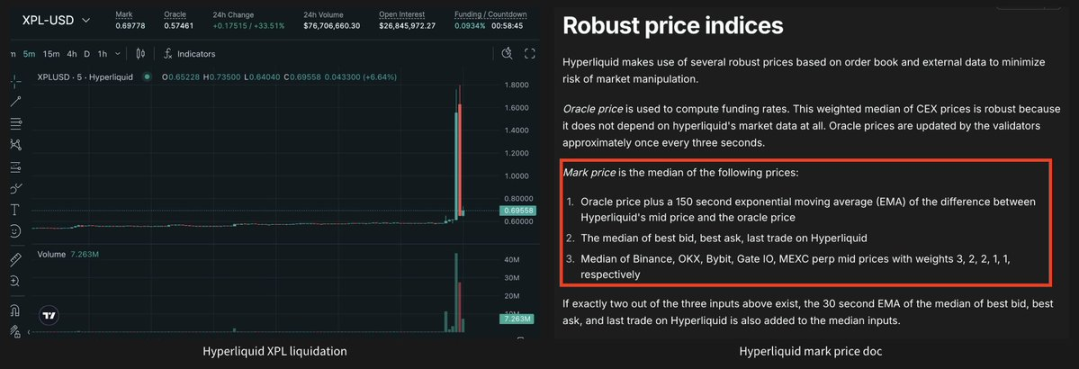
Hyperliquid's XPL Incident and Price Index
The liquidation process lacks transparency and verifiability. Binance claims to use "the median of three sources" for pricing, but on August 25, 2025, the ETH/USDC liquidation price was $4,918, while the visible pricing range at that time was $4,786-$4,862, making the result difficult to explain. Due to the lack of timestamps, liquidations on centralized exchanges are unpredictable and unverifiable. Although Hyperliquid has made some improvements by putting node oracle prices on-chain, the internal matching engine and centralized exchange API have not been verified.
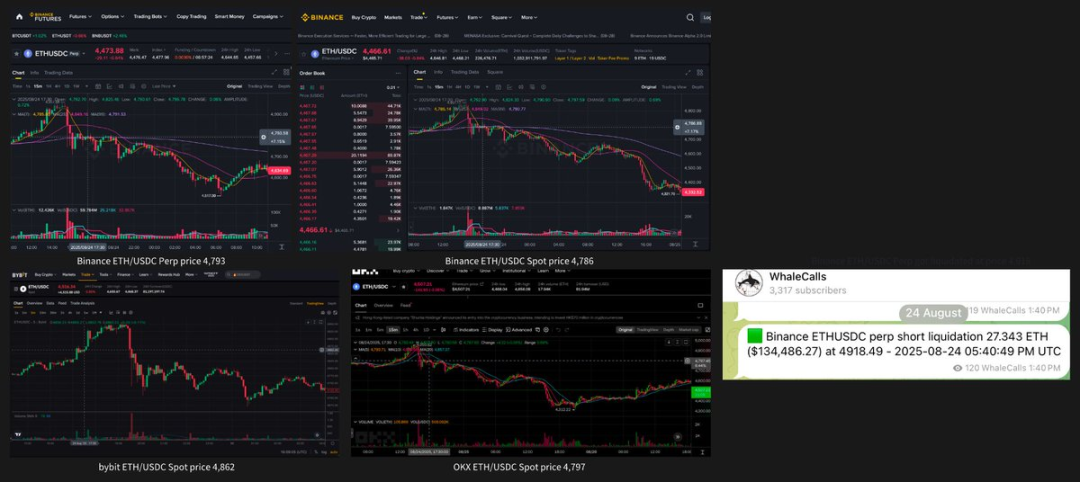
Binance Liquidation Example
The free market has its limitations. Hyperliquid initially adopted a trader-friendly model, allowing traders to freely open positions, and still retaining maintenance margin when liquidation is executed through the order book. However, during the "JELLY incident," the platform was forced to close the market and settle at a price favorable to itself, setting a concerning precedent. Although subsequent additions of isolated automatic deleveraging (ADL) and dynamic open interest (OI) cap mechanisms were made, the XPL incident still exposed similar vulnerabilities.
Essentially, building a liquidation mechanism that is both fair and robust is a highly challenging task. Hyperliquid has taken a bold step towards openness and efficiency, but this "freedom" may also breed vulnerabilities—colluding manipulators could gain an advantage over smaller traders. Introducing volatility caps may be a more ideal direction for improvement.
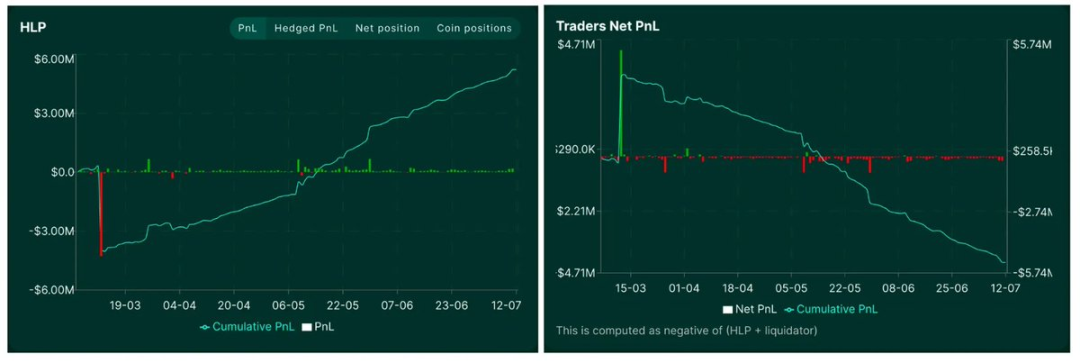
HLP funding pool remains profitable because traders are losing.
Trade Order Sacrifice
The core trade-off in trade ordering lies between "fairness/accessibility" and "efficiency/volume." Hyperliquid chooses to prioritize fairness by setting a "speed buffer" (3-block memory pool buffer + order cancellation priority), protecting retail traders and small market makers from being "harvested" by complex high-frequency trading (HFT). This mechanism creates a more inclusive trading environment, allowing less experienced participants to provide narrow spreads without worrying about adverse selection risks. However, the cost of this protection is that the overall liquidity and trading volume growth of the platform is limited (compared to Binance)—as it hinders the natural "survival of the fittest" competition among market makers, which is precisely the key to driving true price discovery. As Enzo suggested, a "barbell strategy" may simultaneously meet the needs of both retail and high-frequency trading extremes.
Inefficient Margin
Centralized exchanges offer greater margin flexibility because these margins are merely displayed numbers until users withdraw, without requiring actual capital occupation. Decentralized exchanges face greater challenges and cannot simply enhance flexibility by lowering margin requirements. In addition to the conventional cross-margin system, the following strategies can optimize:
- Interest-bearing positions: Short-term government bonds have the lowest risk but come with trade-offs. BlackRock's BUIDL product requires real-name authentication (KYC), while other similar products with looser restrictions lack liquidity. On-chain monthly yield reset mechanisms introduce operational complexity, while Binance's daily annualized yield product RWUSD reflects the advantages of centralized exchanges. Interest-bearing stablecoins have potential but typically lack sufficient liquidity to support perpetual contract trading.

- Separating collateral and margin through lending: Using native assets as collateral to borrow USDC for margin can enhance flexibility. For example, using 1 BTC as collateral to borrow USDC for trading margin. Drift's model allows assets like SOL to be used as collateral based on loan-to-value (LTV), with all trades settled in USDC. However, the risk systems for lending and perpetual contracts differ significantly: in lending scenarios, liquidation failures can lead to bad debts (due to the lack of an automatic deleveraging mechanism); moreover, very few participants are willing to fund insurance, resulting in bad debts ultimately borne by lenders. Centralized exchanges can set risk limits and cover occasional losses with profits, but this is difficult to achieve in the DeFi space, as most liquidation profits go to liquidators, and the protocol itself lacks risk buffer funds.
- Hedge identification in the margin system: An intelligent margin system should be able to identify "natural hedge" positions to reduce margin requirements. For example, when using USDE as collateral while shorting Ethereum (ETH), these two positions are negatively correlated (ETH collateral + ETH short), meaning that bad debts are only likely to occur when the decoupling of the perpetual contract exceeds 90%.
Conclusion
Clearly, the future Perp DEX needs to have a capital-efficient margin system, competitive spreads, extremely low slippage, and strategically deployed incentive mechanisms to build a sustainable development path.
However, there are still key trade-offs in this field, ultimately depending on the protocol's market philosophy: how the platform handles unlimited open interest, how it accommodates large traders, how it balances the execution preferences of retail and high-frequency trading, and how it coordinates trader protection with system security—these subtle differences will greatly impact the platform's user base and use cases.
"Decentralization" is often misunderstood in this field, as most Perp DEX merely shift centralized risks from the "custodial phase" to the more obscure "execution" and "liquidation" phases. A quality protocol should be designed from core values and always maintain robust market integrity. Currently, with advanced infrastructures like LayerZero and Monad, new design solutions are continuously emerging, heralding the arrival of a new generation of Perp DEX.
免责声明:本文章仅代表作者个人观点,不代表本平台的立场和观点。本文章仅供信息分享,不构成对任何人的任何投资建议。用户与作者之间的任何争议,与本平台无关。如网页中刊载的文章或图片涉及侵权,请提供相关的权利证明和身份证明发送邮件到support@aicoin.com,本平台相关工作人员将会进行核查。




